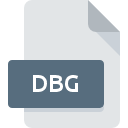.DBG File Extension

Visual FoxPro Debugger Configuration File
| Developer | Microsoft |
| Popularity | |
| Category | Settings Files |
| Format | .DBG |
| Cross Platform | Update Soon |
What is an DBG file?
The .DBG file extension refers to a Debugger Configuration File used primarily by Microsoft Visual FoxPro, an integrated development environment (IDE) for building database applications.
These files play a crucial role in the debugging process of FoxPro applications, storing configuration settings and debugging information necessary for identifying and resolving issues in the code.
More Information.
Visual FoxPro, originally known as FoxBASE+, was developed by Fox Software and later acquired by Microsoft.
The .DBG file format was introduced in Visual FoxPro to facilitate debugging by maintaining configurations and settings specific to the debugging process.
Initially, the purpose of .DBG files was to manage and store debugger-related configurations, such as breakpoints, variable watches, and the state of the debugging session.
These files are integral to the debugging process, allowing developers to control and monitor their code execution effectively.
They enable the Visual FoxPro IDE to maintain a consistent debugging environment across sessions, making it easier to track and resolve issues.
Origin Of This File.
The .DBG file extension originated with Microsoft Visual FoxPro, which was first released in 1984 as FoxBASE. Visual FoxPro evolved from earlier versions of FoxBASE, with significant updates and changes over the years.
The inclusion of .DBG files became a part of the debugging tools integrated into the FoxPro environment to enhance developers’ ability to troubleshoot and optimize their applications.
File Structure Technical Specification.
The structure of a .DBG file is designed to support Visual FoxPro’s debugging capabilities. While the exact internal structure of .DBG files is not widely documented, they generally contain:
- Breakpoint Information: Details about where breakpoints are set in the source code.
- Variable Watch Data: Information on variables being monitored during debugging.
- Call Stack Information: Data on the current call stack to track function calls and returns.
- Debugger Settings: Various configuration settings for the debugging environment, such as display options and error handling preferences.
Typically, .DBG files are binary files, which means they are not easily readable or editable by humans. They are created and managed by Visual FoxPro and contain data that is specifically formatted for use by the debugger.
How to Convert the File?
Converting a .DBG file to another format is not straightforward due to its specialized nature and binary format.
Generally, .DBG files are not intended to be converted but rather used directly within Visual FoxPro. However, if you need to transfer debugging settings or configurations to another environment, consider the following approaches:
- Manual Recreation: Manually recreate debugging settings in the new environment based on the configurations in the .DBG file. This method can be time-consuming but ensures that settings are accurately transferred.
- Export Features: Some versions of Visual FoxPro may offer export features that allow you to save debugging configurations in a more portable format, such as text or XML. Check the documentation for your specific version of Visual FoxPro for any export options.
- Custom Scripts: In some cases, developers may write custom scripts to parse and extract information from .DBG files. This approach requires programming knowledge and a good understanding of the file’s structure.
Advantages And Disadvantages.
Advantages:
- Enhanced Debugging: .DBG files store essential debugging configurations, making it easier to track and fix issues in the code.
- Session Consistency: They help maintain a consistent debugging environment across different sessions, improving the efficiency of the debugging process.
- Efficient Troubleshooting: By storing breakpoints and variable watches, .DBG files enable developers to quickly identify and address problems in their code.
Disadvantages:
- Proprietary Format: The binary nature of .DBG files and their reliance on Visual FoxPro makes them inaccessible to users of other development environments or debugging tools.
- Limited Use: .DBG files are specific to Visual FoxPro, limiting their utility to developers working within that ecosystem. They are not used in other programming environments.
- Potential Corruption: Like other configuration files, .DBG files can become corrupted, leading to potential issues with debugging or loss of settings.
How to Open DBG?
Open In Windows
- Visual FoxPro IDE: The primary method for opening and using .DBG files is through Microsoft Visual FoxPro. When debugging an application, Visual FoxPro automatically generates and manages .DBG files.
- File Association: Windows does not natively associate .DBG files with any application outside of Visual FoxPro. Therefore, double-clicking on a file will not open it in a readable format but may prompt Visual FoxPro if installed.
Open In Linux
- Virtualization or Emulation: Similar to macOS, Visual FoxPro is not natively available for Linux. To open .DBG files, you would need to use a Windows emulator or virtual machine running Visual FoxPro.
- Remote Access: You can also use remote desktop solutions to access a Windows environment where Visual FoxPro is installed.
Open In MAC
- Virtualization or Emulation: Visual FoxPro is not natively supported on macOS. To work with .DBG files on a Mac, you would need to use virtualization software (e.g., Parallels Desktop) or set up a Windows virtual machine where Visual FoxPro can be installed and used.
- Remote Access: Alternatively, you can access a Windows environment via remote desktop or network sharing if Visual FoxPro is installed on a Windows machine.












